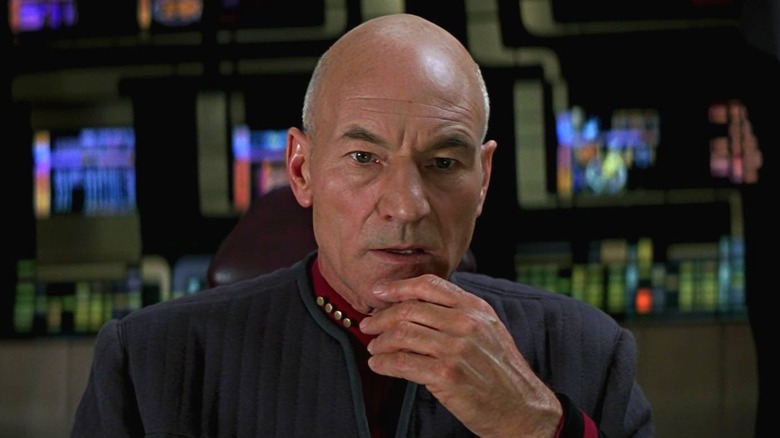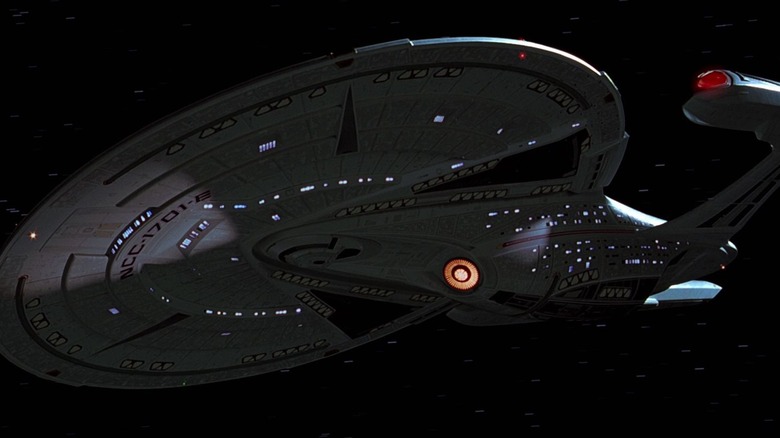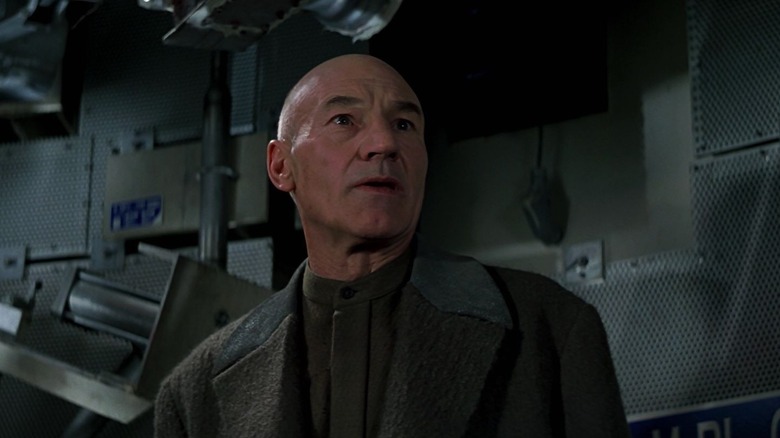Patrick Stewart Refused To Do One Thing For Star Trek: First Contact
After the release of "Star Trek: Generations" in 1994, the various "Trek" writers felt a great weight lifted. There were a lot of strange story requirements in place when adapting "Star Trek: The Next Generation" to the big screen for the first time, and writers Ron D. Moore and Brannon Braga bent over backwards to invent a story that fulfilled every mandate. They managed to check every box — original "Star Trek" cast members in the first 10 minutes only, Klingons had to be involved, time travel had to be a plot element — but "Generations" feels scattered as a result. It ultimately served as a "passing of the torch" from Captain Kirk (William Shatner) to Captain Picard (Patrick Stewart), which was wholly unnecessary, given that Picard had already headlined his own TV series for seven seasons.
When the time came to write a sequel, Braga and Moore suddenly felt a lot freer. They could construct whatever kind of story they wanted, and bring back whatever villain from the TV show they wanted. It didn't take too long before the writers decided they wanted another time travel story, and they definitely wanted it to involve the Borg. The Borg, a species of soulless cyborgs, had appeared on several episodes of "Next Generation" and terrified audiences with their mechanical ability to assimilate technology, and people, into their collective. It was high time they appeared on the big screen.
Braga and Moore recalled the "First Contact" brainstorming sessions with clarity in the oral history book "The Fifty-Year Mission: The Next 25 Years: From The Next Generation to J.J. Abrams," edited by Mark A. Altman and Edward Gross. Braga and Moore recall pushing their minds through various periods of human history, trying to think of a time when the Borg's appearance would be the most devastating. For a hot minute (really a few weeks), Braga felt that a Borg attack in 16th-century Europe would have been keen. Sadly, when the idea made its way to Patrick Stewart, the actor put the kibosh on any medieval dramas, as he heartily refused to wear tights on the big screen.
Stewart refused to wear tights in Star Trek: First Contact
To remind readers, the final version of "Star Trek: First Contact" saw the USS Enterprise use a Borg-created time hole to travel back in time to 2063, a year significant to the "Trek" timeline. In 2063, humanity was recovering from a devastating war, and nations were scattered. It was also the year an enterprising engineer named Zefram Cochran (James Cromwell) built the first ever faster-than-light engine. In "Star Trek" lore, Cochran tested his warp engine just as a ship full of Vulcans happened to be passing nearby, and it attracted their attention. The Vulcan landed on Earth, and humanity suddenly realized they weren't alone in the universe. The meeting — called First Contact — ushered in a new utopian era of peace and prosperity. The Borg's time travel shenanigans would have ultimately stopped all that from happening.
It was perhaps wise for Braga and Moore to stick to "Trek" lore — and their story very much expanded the "Trek" universe — but for a long time, Braga really liked the idea of the Borg attacking a medieval world, and dressing the "Star Trek" actors in period-appropriate clothing. He explained his thought process like this:
"I was eager to do time travel again, because I was stinging from that Nexus crap in 'Generations.' Also, we were waiting for 'First Contact' to really dip back into the Borg. But I have to say, our initial ideas for the movie were pretty lame. We were talking about the Borg traveling back to medieval times, the 1500s. It was just insane. We talked about that for a few weeks, and Patrick got wind of it through [executive producer] Rick [Berman], and he refused to wear tights on the big screen. That was his quote. But it was a dumb idea to begin with."
It wasn't a dumb idea, although Stewart and the case likely had their fill of medieval costumes after playing Robin Hood characters in the "Next Generation" episode "Qpid," which aired in April of 1991.
The film's writers considered multiple eras for the movie
Moore recalled a few other time travel locations he wanted to try before ultimate deciding on 2063. He was quoted as saying:
"We went through a variety of time periods during the development process, from the Italian Renaissance to the present to the Civil War. Nothing really got that far, but we talked about a lot of different periods in terms of what would be interesting, where the Borg would go and why, and what we could do there. We realized fairly quickly that there's been a lot of time travel done. Almost any period you go to has been done in one way, shape, or form. Then we came up with the idea of doing the near future and to involve what is essentially the birth of 'Star Trek.'"
Indeed, before the release of "First Contact" in 1996, there had already been episodes of "Star Trek" to feature the cast in ancient Roman garb, dressed as medieval figures, or even wearing caveman skins. In 1986, "Star Trek IV: The Voyage Home" sent its characters back in time to the present, and shortly after "First Contact," "Star Trek: Voyager" would have a time travel story wherein the characters go back in time to 1996. It seems the present was already well-covered.
Instead, they elected to visit the near future, and, as Moore said, witness the origin story for the "Trek" utopia. It was ultimately a pretty good choice.


